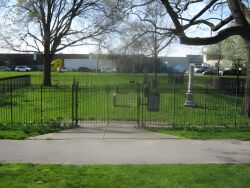Joseph Rodman Drake Park & Enslaved African Burial Ground
Joseph Rodman Drake Park
The property of Joseph Rodman Drake Park in the Hunts Point area of the Bronx is located in what was once a Weckquaesgeek Indian settlement. In the late 17th century Thomas Hunt--for whom the neighborhood is named--acquired a large estate that encompassed this modest site, and built his stone residence, "the Grange", down by the shoreline point.
The Hunt property would later serve as a rural childhood retreat for Hunt family friend, Joseph Rodman Drake. Born in New York City on August 7, 1795, Joseph Rodman Drake was a distant descendant of the famous 16th-century navigator Sir Francis Drake. Orphaned early and raised in Manhattan, he showed early promise as a poet, and his verse made reference to the natural beauty of the Bronx. In 1813 Drake began studying medicine with local doctors, and around this time befriended poet Fitz-Greene Halleck. From March to July 1819, they collaborated on “The Croaker Papers.” This series of satirical poems lampooning City officials was published in the New York Evening Post.
Although he worked as a physician, Drake was best known as a celebrated author of poems such as “The Culprit Fay” and “The American Flag.” When he died of tuberculosis at the age of twenty-five on September 21, 1820, Drake was laid here to rest in the Hunt family burial ground north of the Grange. Halleck (whose sculpture stands in Central Park) wrote the epitaph on Drake’s tombstone: “Green be the turf above thee; Friend of my better days; None knew thee but to love thee; Nor named thee but to praise.” Drake’s widow compiled and published posthumously a collection of his poems in October 1835.
The burial ground at Drake Park consists of more than 40 markers, some dating to the early 18th century, which includes names such as Hunt, Leggett, and Willett--all families associated with the settlement and development of the Bronx. The streets near the cemetery are named for prominent poets including Drake, Halleck, (John Greenleaf) Whittier, and (Henry Wadsworth) Longfellow. In 1905 the cemetery was saved from destruction by local literary enthusiasts. Four years later, Parks acquired the property.
Located south of Drake Cemetery, on a dry mound in the surrounding wetlands by old Hunts Point Road, was the Slave Burial Ground. Separated from their masters' graves, dozens of enslaved Africans, were interred beyond the consecrated ground of Drake Cemetery, their burials marked by simple gravestones. Here lie the nanny, coachman, farm laborer, wood cutter, drover, blacksmith, cook, groom, carpenter and seamstress, whose unpaid labor contributed to Hunts Point’s large profitable estates from colonial times to 1827, when slavery was abolished in New York State.
According to the 1800 federal census, 44 enslaved Africans lived on the Hunts Point peninsula. The last burial in the Slave Burial Ground reportedly occurred in the 1840s, when the former Leggett slave Aunt Rose was laid to rest next to the enslaved family members and friends with whom she grew up. The Slave Burial Ground was graded away and covered with dirt, gravel or asphalt sometime in the early years of the 20th century succumbing to roadway construction and development prior to the park’s establishment. In 2013, a local history education project conducted with school children at nearby P.S. 48 unearthed much of this forgotten historical chapter.
The park was named in honor of Joseph Rodman Drake in 1915. That year, the Bronx Society of Arts and Science installed a seven-foot high marble shaft inscribed with Halleck’s words to mark Drake’s grave. The Society placed another tablet in Drake’s honor near the Lorillard Snuff Mill in the New York Botanical Garden. A 1934 survey at the site indicated a stone dwelling, metal garage and tool shed on the grounds of the park, perhaps vestiges of the caretaker's home of the former estate. These features were no longer in place when a major renovation was undertaken in 1953. At that time, an iron picket fence was installed around the cemetery, benches were placed along the paths and cinder sidewalks were built along the perimeter. In 1961, many of the gravestones of the central cemetery were vandalized and subsequently stabilized. Some were removed, and acid rain and weathering have further eroded the remaining markers.
As the surrounding neighborhood has grown predominantly industrial, the park has provided an oasis with venerable trees; its pastoral beauty and historic graveyard an enduring connection to the origins of the Bronx.
Check out your park's Vital Signs
Clean & Safe
Green & Resilient
Empowered & Engaged Users
Share your feedback or learn more about how this park is part of a
Vital Park System









